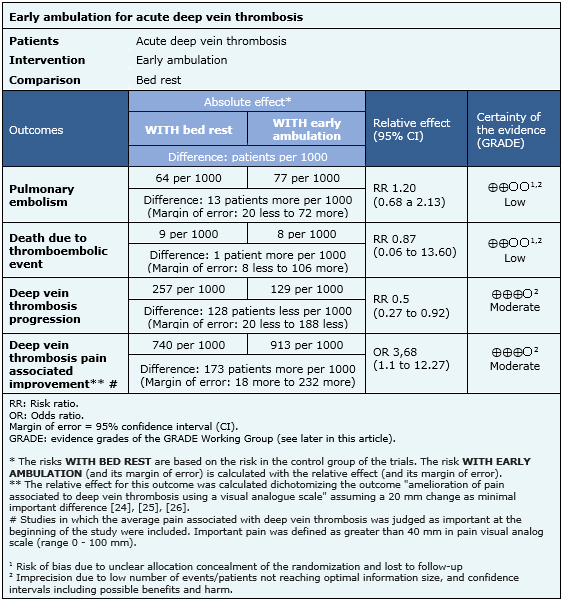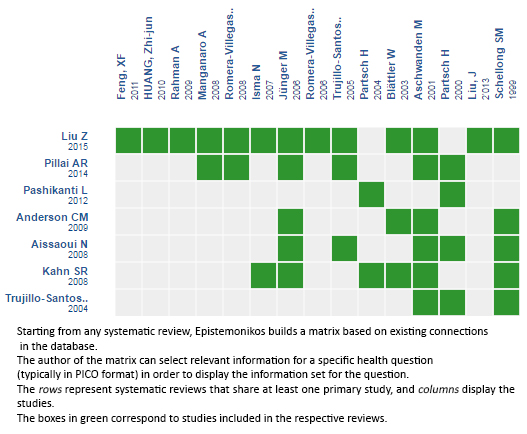Epistemonikos summaries
← vista completaPublished on June 28, 2016 | http://doi.org/10.5867/medwave.2016.6478
Early mobilization versus bed rest for deep vein thrombosis
Deambulación precoz versus reposo para pacientes con trombosis venosa profunda
Abstract
Aiming to prevent thromboembolic events, bed rest was historically considered in the management of patient with deep vein thrombosis. Nevertheless early ambulation could have beneficial effects. Searching in Epistemonikos database, which is maintained by screening 30 databases, we identified seven systematic reviews including 10 randomized trials answering this question. We combined the evidence using meta-analysis and generated a summary of findings table following the GRADE approach. We concluded early ambulation is probably effective in reducing deep vein thrombosis progression and improving limb pain, and might not increase the risk of thromboembolism.
Problem
Bed rest has been considered standard treatment of patients with deep venous thrombosis based on the assumption that rest decreases the risk of deep venous thrombus detachment and subsequent pulmonary embolism [1]. However, bed rest may have negative consequences, such as work absenteeism or morbidity associated with immobilization. In this context, it has been proposed that early mobilization might be a better alternative for these patients.
Methods
We used Epistemonikos database, which is maintained by screening more than 30 databases, to identify systematic reviews and their included primary studies. With this information we generated a structured summary using a pre-established format, which includes key messages, a summary of the body of evidence (presented as an evidence matrix in Epistemonikos), meta-analysis of the total of studies, a summary of findings table following the GRADE approach and a table of other considerations for decision-making.
|
Key messages
|
About the body of evidence for this question
|
What is the evidence. |
We found seven systematic reviews [2],[3],[4],[5],[6],[7],[8] considering 13 primary studies [9],[10],[11],[12],[13], [14],[15],[16],[17],[18],[19],[20],[21],[22],[23] including 10 randomized controlled trials [9],[10],[11],[12],[13],[14],[15],[16],[17],[18],[19],[20] and three observational studies [21],[22],[23]. This table and the analysis as a whole is based on the randomized controlled trials. |
|
What types of patients were included |
Patients with a diagnosis of acute deep vein thrombosis. |
|
What types of interventions were included |
Early ambulation compared with forced bed rest. Both strategies were associated with anticoagulation. |
|
What types of outcomes |
Pulmonary thromboembolism, death due to thromboembolic event, deep vein thrombosis progression and pain associated with deep vein thrombosis. |
Summary of findings
The information about the effects of early ambulation on deep vein thrombosis is based on 10 randomized controlled trials including 927 patients. Eight randomized controlled trials reported incidence of pulmonary embolism (including 863 patients), three trials reported death due to thromboembolic event (including 231 patients), three trials reported deep vein thrombosis progression (including 171 patients) and five trials reported pain associated with deep vein thrombosis (including 287 patients). The summary of findings is the following:
- Early ambulation probably results in improvement of pain associated with deep vein thrombosis. The certainty of the evidence is moderate.
- Early ambulation probably reduces the likelihood of progression of deep vein thrombosis. The certainty in the evidence is moderate.
- Early ambulation may not significantly increase the risk of pulmonary embolism in relation to the strategy of forced bed rest. The certainty of the evidence is low.
- Early ambulation may not significantly increase the risk of death due to a thromboembolic event in relation to the strategy of forced bed rest. The certainty of the evidence is low.


Other considerations for decision-making
|
To whom this evidence does and does not apply |
|
| About the outcomes included in this summary |
|
| Balance between benefits and risks, and certainty of the evidence |
|
| What would patients and their doctors think about this intervention |
|
| Resource considerations |
|
|
Differences between this summary and other sources |
|
| Could this evidence change in the future? |
|
How we conducted this summary
Using automated and collaborative means, we compiled all the relevant evidence for the question of interest and we present it as a matrix of evidence.

Follow the link to access the interactive version: Early mobilization versus bed rest for deep vein thrombosis
Notes
The upper portion of the matrix of evidence will display a warning of “new evidence” if new systematic reviews are published after the publication of this summary. Even though the project considers the periodical update of these summaries, users are invited to comment in Medwave or to contact the authors through email if they find new evidence and the summary should be updated earlier. After creating an account in Epistemonikos, users will be able to save the matrixes and to receive automated notifications any time new evidence potentially relevant for the question appears.
The details about the methods used to produce these summaries are described here http://dx.doi.org/10.5867/medwave.2014.06.5997.
Epistemonikos foundation is a non-for-profit organization aiming to bring information closer to health decision-makers with technology. Its main development is Epistemonikos database (www.epistemonikos.org).
These summaries follow a rigorous process of internal peer review.
Conflicts of interest
The authors do not have relevant interests to declare.

